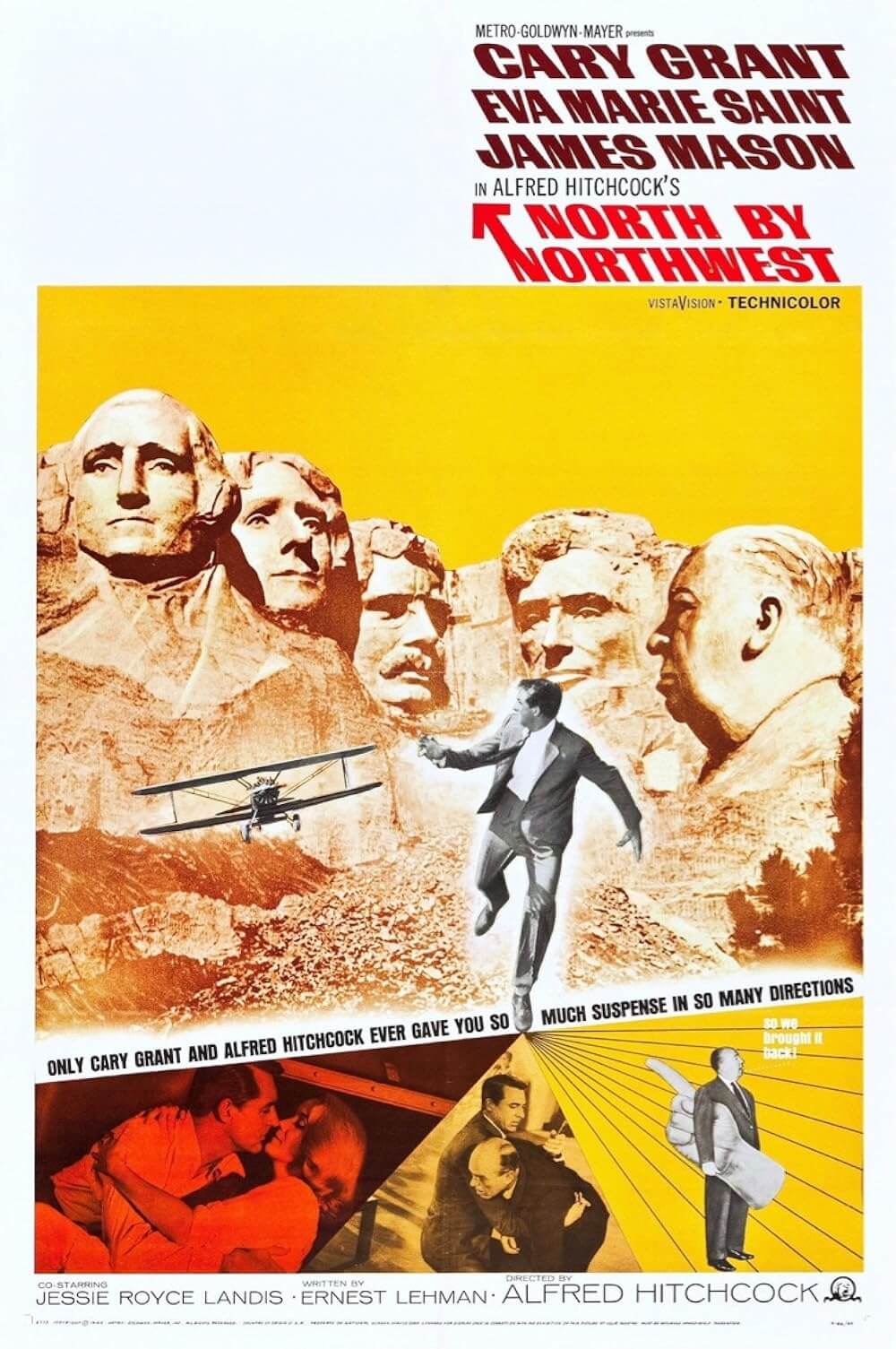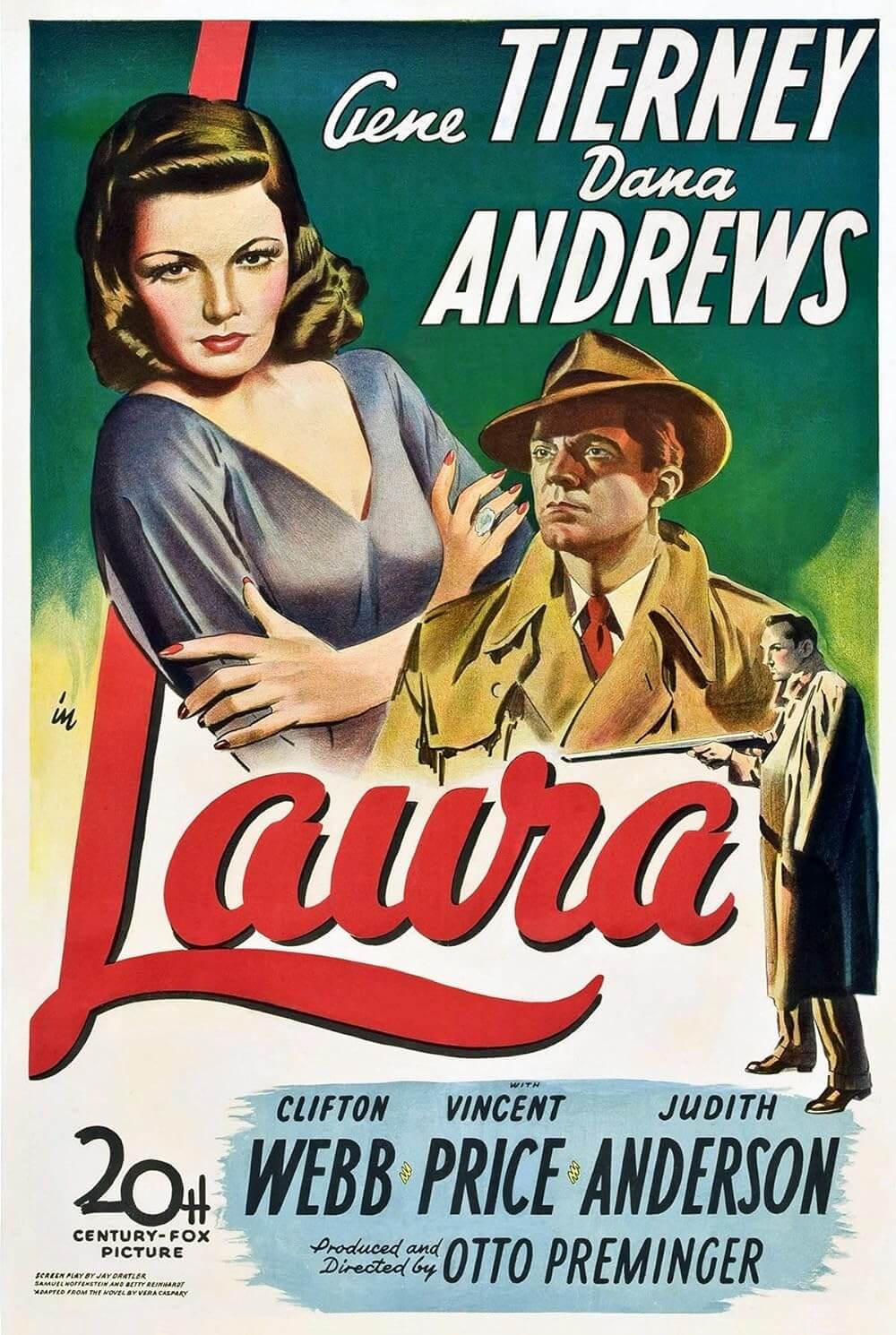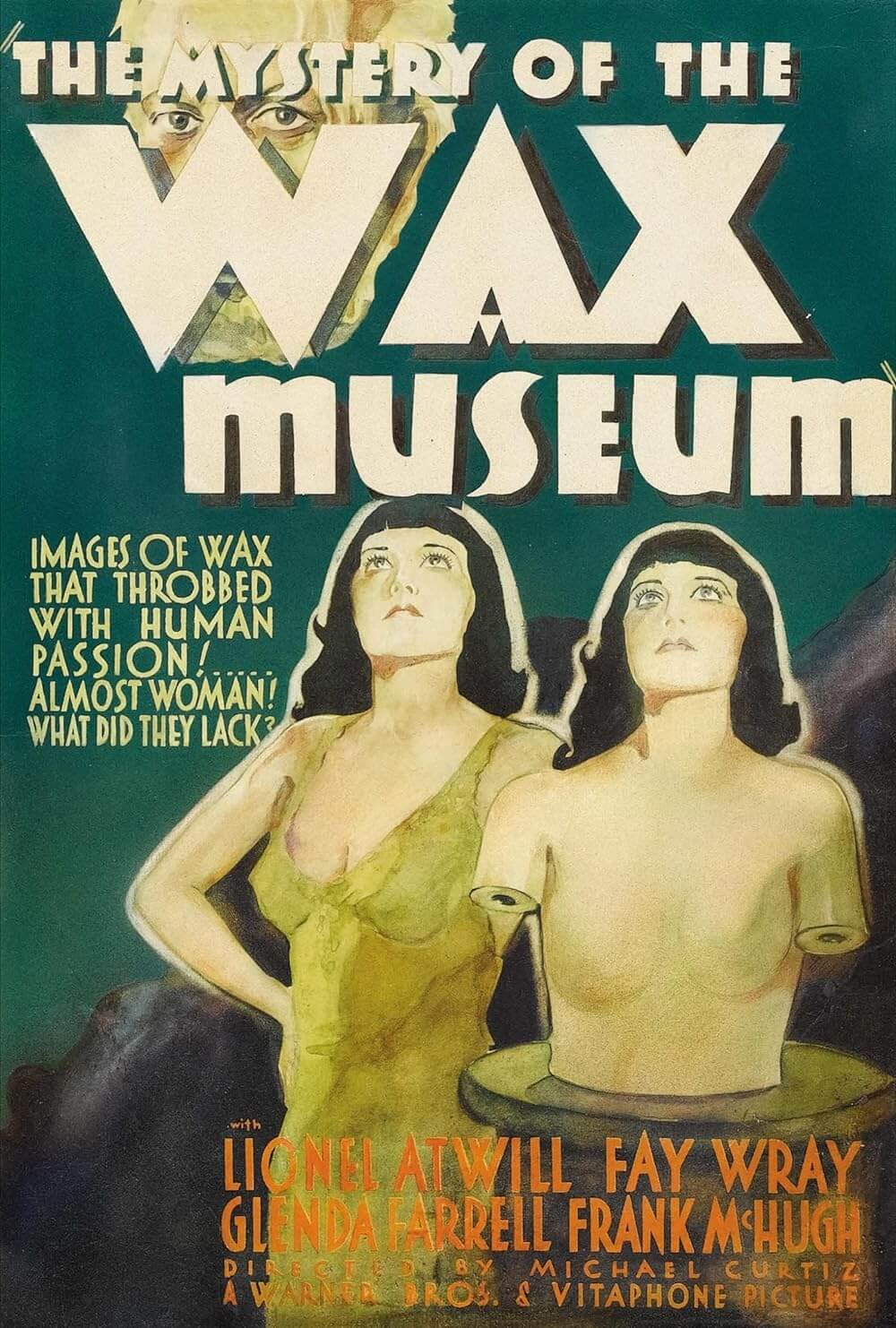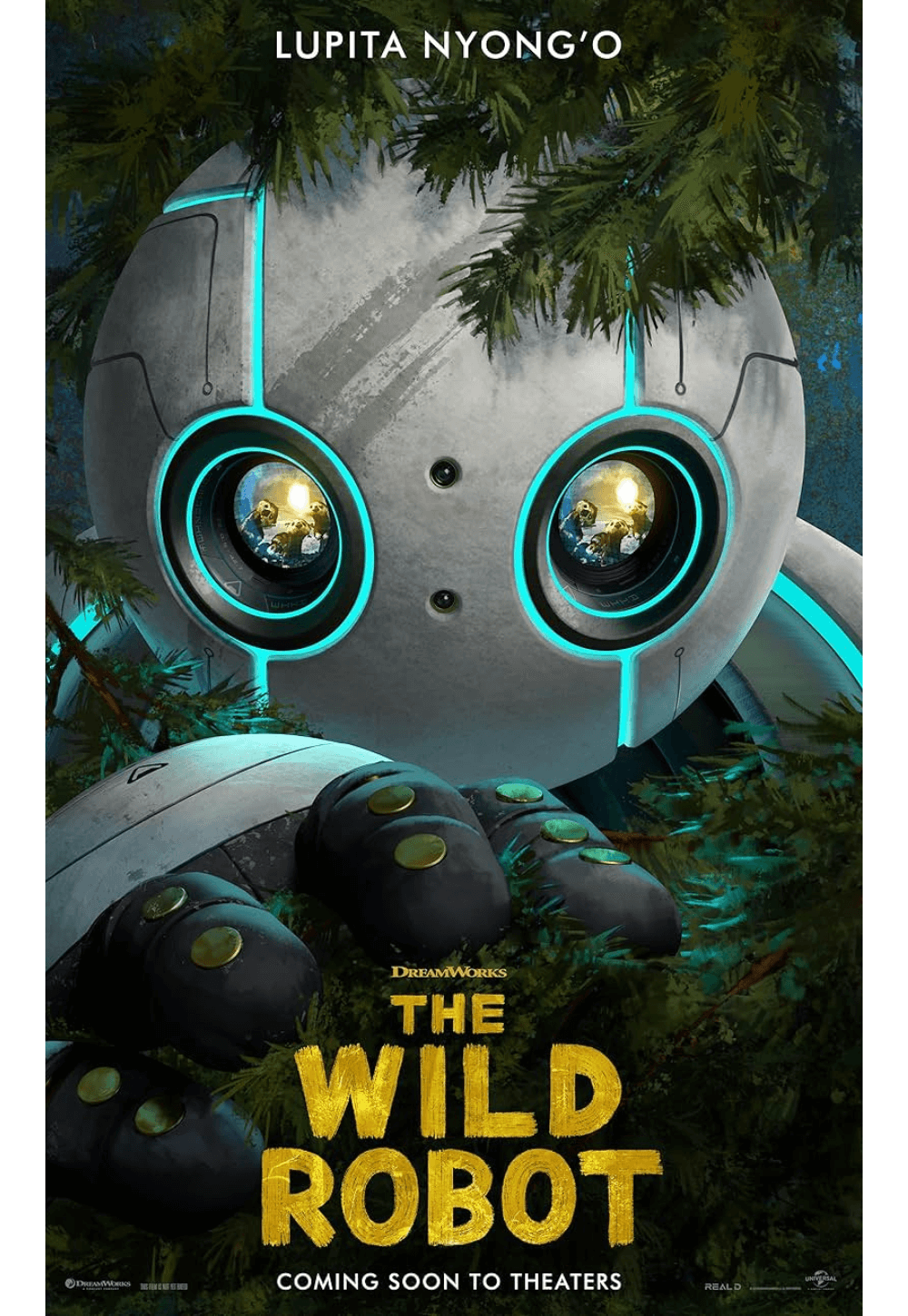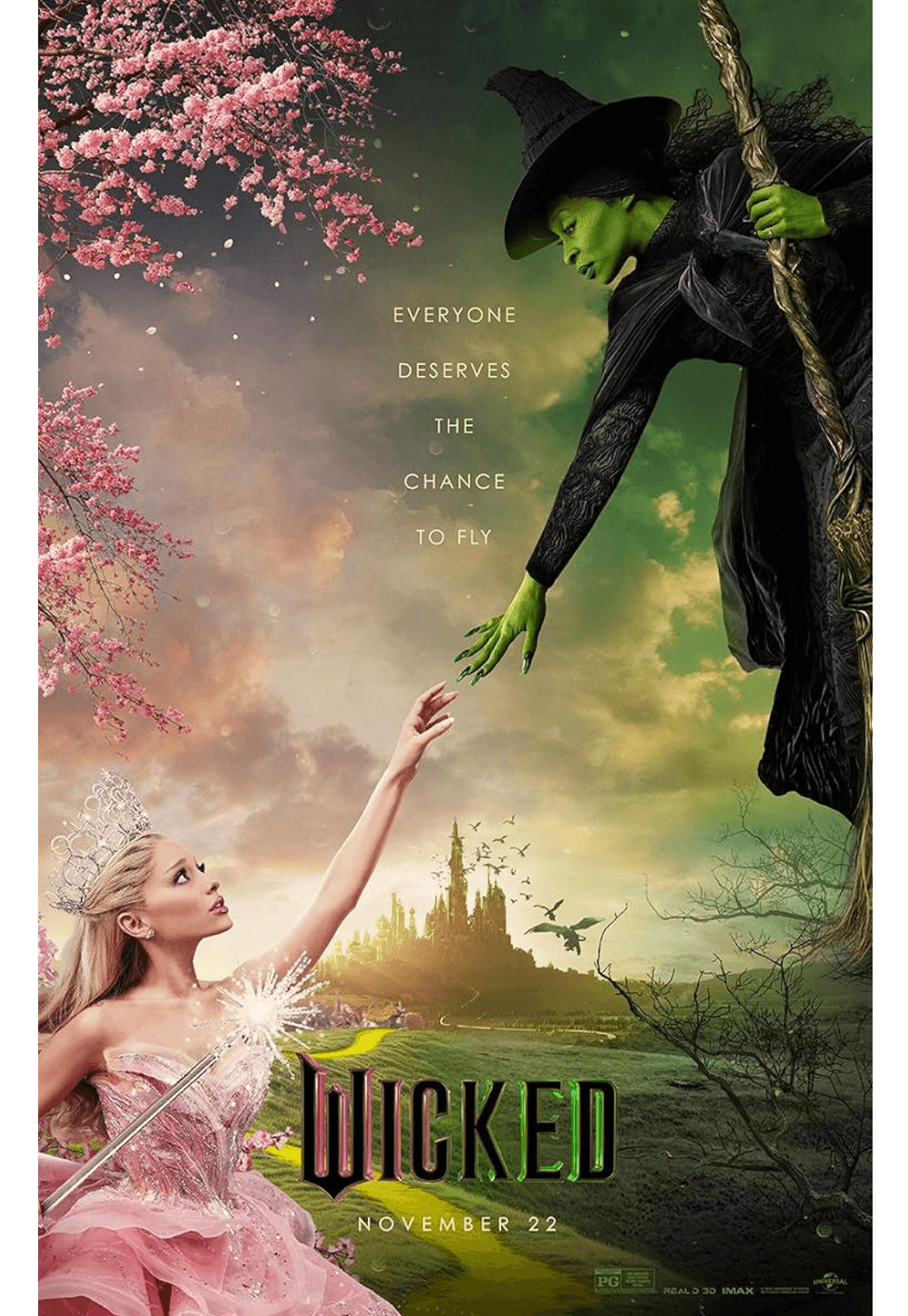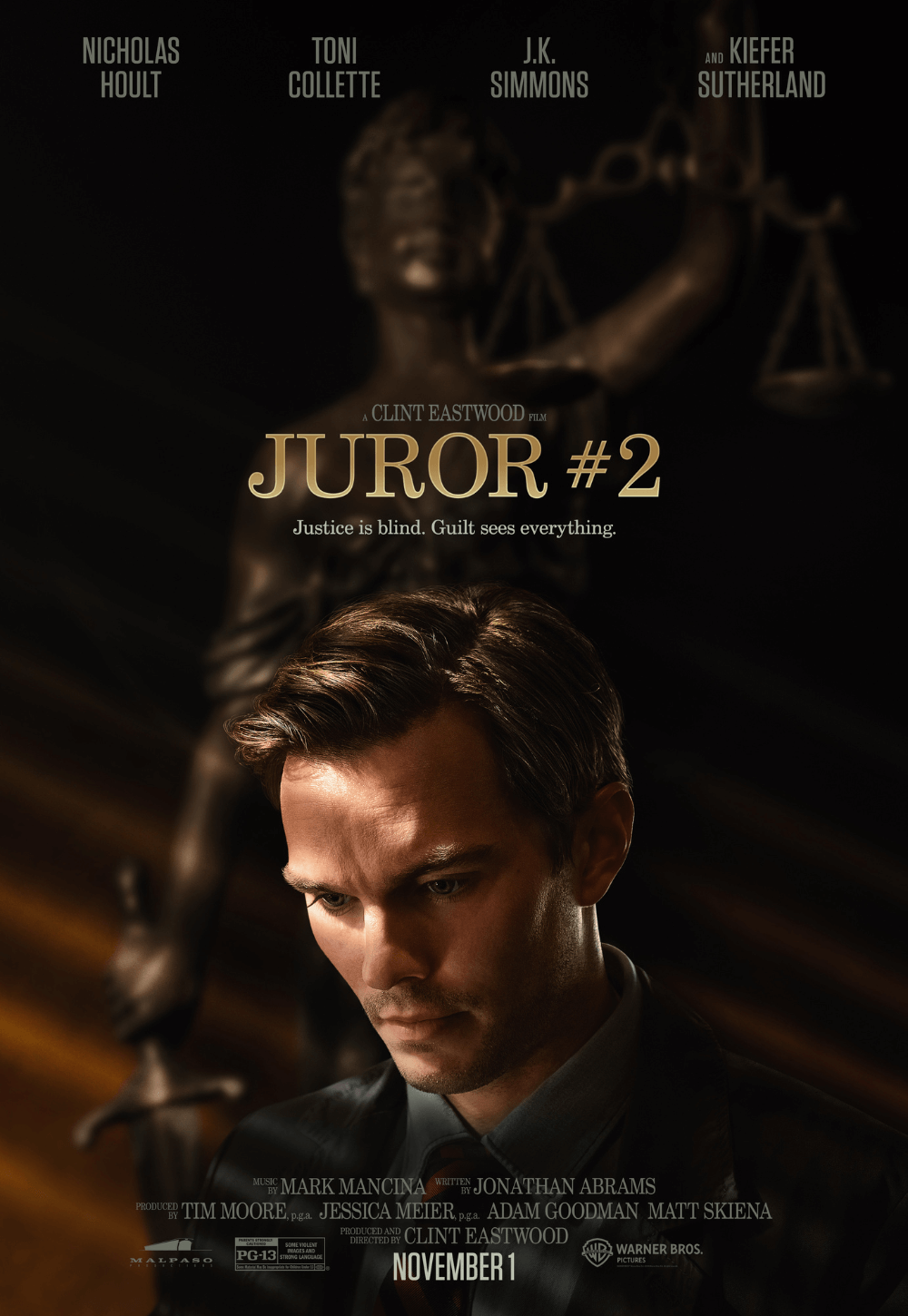The Definitives

The Night of the Hunter
Essay by Brian Eggert |
(This essay was originally published on November 23, 2010. It has been edited and expanded.)
The Night of the Hunter is a strange film. Nothing quite compares. Its unusualness draws influence from German Expressionism and Mother Goose. Yet the story, set in a Southern Gothic backdrop, explores how religion can be corrupted for greed, murder, and lust. Released in 1955, it would become the only film directed by renowned actor Charles Laughton, who approached filmmaking in the same manner as his acting—from a place of keen human observation and the layering of a master painter. But the film is not the product of an established auteur. Under Laughton’s untested direction, the production fostered a contingent of film-workers with the creative latitude to shape the picture through an inspiring account of artistic collaboration. Laboring toward their director’s singular vision, Laughton’s cast and crew developed enduring imagery both startling and beautiful, ideas both complex and disturbing. Their approach was experimental yet assured, combining the threat of a slit throat with the tenderness of a lullaby. Divergent from every known formula, The Night of the Hunter’s arrangement of graceful cinematography and unnerving impulses channels a cinematic dreamscape of desire and terror, which awakens the unconscious and continues to challenge the creative limits of cinema.
Part folk tale, part horror story, the film’s amalgamation of moods and methods is arcane, even off-putting upon first assessment. Based on Davis Grubb’s 1953 novel, The Night of the Hunter shifts perspectives between characters, from a child’s point of view to that of a murderer. And with these dramatic tonal switches, the stylistic approach turns as well—in sometimes abrupt and disorienting transitions, such as when noirish photography gives way to bright rural landscapes suited for a storybook. Such rich contrasts of style remain inventive but elusive, even beguiling. It’s impossible to make sense of the film in a single viewing—or even in two or three. Yet, unique as its mannerisms prove, the effect retains a place in the memory of those who experience it. Motion pictures this distinctive have a way of mesmerizing an audience with their mysteries of style and narrative, instilling a seed that germinates over time and grows into an emergent affection that lingers in the viewer’s unconscious. As a result, audiences and critics alike dismissed the picture in 1955. But slowly, and after much reassessment, the film has gained esteem so that today it is hailed as one of cinema’s most extraordinary oddities.
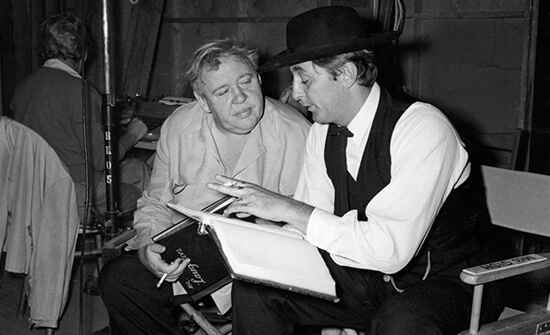 When The Night of the Hunter first played in France, then-critic François Truffaut gave the film one of its only rave reviews from the period, calling it “an experimental cinema that truly experiments, and a cinema of discovery that, in fact, discovers.” The experimentations identified by Truffaut reside in the film’s variations of tone and style—how some shots appear composed more for their unconscious effect rather than a readable symbolic intent. To match the film’s novel-like shifts in perspectives, Laughton relies on patterns of influence that also shift and range from the silent pictures of D.W. Griffith to The Cabinet of Dr. Caligari (1920) to storybook fantasies. Yet it all comes together to form a whole—a weirdly organic construction filled with stylistic contradictions that are anything but random. Rather, Laughton and his production crew toiled at length to achieve the film’s unmatched diversity of style. Together, they created one of cinema’s purest examples of filmmaking as it should be: a collaborative art form. What’s even more astute about Truffaut’s assessment is that he predicted the film would be Laughton’s only venture as a director—and all the more impressive for his willingness to explore the medium’s limits.
When The Night of the Hunter first played in France, then-critic François Truffaut gave the film one of its only rave reviews from the period, calling it “an experimental cinema that truly experiments, and a cinema of discovery that, in fact, discovers.” The experimentations identified by Truffaut reside in the film’s variations of tone and style—how some shots appear composed more for their unconscious effect rather than a readable symbolic intent. To match the film’s novel-like shifts in perspectives, Laughton relies on patterns of influence that also shift and range from the silent pictures of D.W. Griffith to The Cabinet of Dr. Caligari (1920) to storybook fantasies. Yet it all comes together to form a whole—a weirdly organic construction filled with stylistic contradictions that are anything but random. Rather, Laughton and his production crew toiled at length to achieve the film’s unmatched diversity of style. Together, they created one of cinema’s purest examples of filmmaking as it should be: a collaborative art form. What’s even more astute about Truffaut’s assessment is that he predicted the film would be Laughton’s only venture as a director—and all the more impressive for his willingness to explore the medium’s limits.
Laughton’s professional acting career began in 1926 after a brief stint at the Royal Academy of Dramatic Art. He achieved immediate acclaim in many significant roles, bringing his grandiosity to each performance. He was the foremost presence on the English stage within five years, later moving to Broadway and after that Hollywood. In his early films, he became known for bombastic characterizations, such as his Henry in The Private Lives of Henry VIII (1933) or Captain Bligh in Mutiny on the Bounty (1935), all culminating with his signature role as Quasimodo in The Hunchback of Notre Dame (1939). After his acclaimed performance as the Hunchback, his roles turned into easier evocations of his personality, but no less rich, such as those in Jules Dassin’s version of The Canterville Ghost (1944) or David Lean’s Hobson’s Choice (1954), versus the total embodiments that came before. His creative drive shifted toward directing theatrical productions for the stage. However, he continued to act in more commercial roles, which he said used up a mere “tenth” of his creative energies. His manager Paul Gregory knew Laughton should be directing motion pictures.
Gregory believed, somewhat naïvely, that with good art comes good business, and accordingly, he took creative risks as a producer. He became Laughton’s manager after seeing the actor read a chapter from the Bible’s book of Daniel on The Ed Sullivan Show. Gregory immediately sought out the actor to propose a one-man show where Laughton would read selections from classic literature to a rapt audience. Costume-free readings of material like Don Juan in Hell, along with productions of John Brown’s Body and The Caine Mutiny Court-Martial, followed until Gregory realized that Laughton’s organization of these shows gave evidence of the actor’s incredible talent for composing more than a single performance but an entire arrangement—and that more significant directing challenges awaited in film. Gregory later received a call from a publisher friend in New York City who offered him a chance to read a yet-unpublished novel by first-time author Davis Grubb. Gregory read Grubb’s The Night of the Hunter and, immediately after finishing the book, he wanted Laughton to put the story to film.
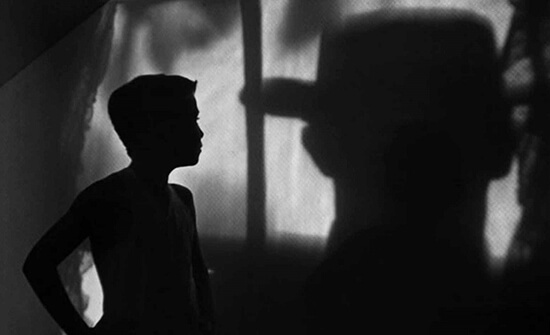 In the tradition of Charles Dickens and Hans Christian Andersen, Grubb’s novel comes from a myriad of influences that represent a unique balance between a rustic style and the exploration of fantastic, even supernatural realms. The author carefully distinguishes scenes by prose that remains cinematic in its descriptions and structure, which is perhaps why Gregory was so attracted to the novel. Grubb, who grew up on the Ohio River, marries the influence of Mark Twain and storybook writer Howard Pyle (famous for The Merry Adventures of Robin Hood) through his narrative, which puts forth an intended allegory for good and evil. Good is represented by the innocence of children and the kindness of strangers. Evil is epitomized in a murderous Preacher, whose formation came about during one of Grubb’s night owl research ventures into his seedy subjects. In a bar one night, he saw a man with “L-O-V-E” tattooed on the fingers of one hand and “H-A-T-E” tattooed on the other. Grubb would declare the subject of his novel was “religious fakery,” or the misguided behavior from “religious bigotry and fanaticism.”
In the tradition of Charles Dickens and Hans Christian Andersen, Grubb’s novel comes from a myriad of influences that represent a unique balance between a rustic style and the exploration of fantastic, even supernatural realms. The author carefully distinguishes scenes by prose that remains cinematic in its descriptions and structure, which is perhaps why Gregory was so attracted to the novel. Grubb, who grew up on the Ohio River, marries the influence of Mark Twain and storybook writer Howard Pyle (famous for The Merry Adventures of Robin Hood) through his narrative, which puts forth an intended allegory for good and evil. Good is represented by the innocence of children and the kindness of strangers. Evil is epitomized in a murderous Preacher, whose formation came about during one of Grubb’s night owl research ventures into his seedy subjects. In a bar one night, he saw a man with “L-O-V-E” tattooed on the fingers of one hand and “H-A-T-E” tattooed on the other. Grubb would declare the subject of his novel was “religious fakery,” or the misguided behavior from “religious bigotry and fanaticism.”
Laughton, however, interpreted Grubb’s book to be about the defeat of childhood demons, analogous to fairy tales where the child hero defeats a wicked witch preying on children—he called it “a fairy-story, really a nightmarish sort of Mother Goose tale.” On the set, Laughton regularly referred to his star Lillian Gish as “Mother Goose” to shape the actress’ maternal savior role. Laughton’s adaptation was atypical in that he wanted his film to serve the novel by maintaining its themes and imagery. To this end, James Agee seemed the perfect choice to adapt Grubb’s book. Agee had written many screenplays but had only received credit for John Huston’s The African Queen (1951); he also worked as a novelist, film critic, and poet. He had a similar background to Grubb, having written in the Depression-era backdrop of Grubb’s novel before. Moreover, at the time of his hiring, Agee was also writing his posthumously published book, A Death in the Family, a tale told from a child’s perspective, which much of Grubb’s novel and the film would be. The fit was natural, but perhaps Agee was too close to the material. When the writer turned in an overly detailed adaptation of Grubb’s novel that, totaling around 300 pages, clung to the author’s words, Laughton took it upon himself to rewrite Agee’s version into a script of suitable length, editing down and reinterpreting the material through story conferences between writer and director. And despite the need for Laughton to extensively rework Agee’s script, the relationship between all parties remained professional, if combustive at times. Though the resulting script had been drastically reduced from Agee’s version, Laughton did not argue when Agee received sole screen credit. They were Agee’s words, just revised by Laughton.
The screen story opens with a procession of deeply conflicting scenes that anticipate the film’s shifts in style. The first features the face of Lillian Gish superimposed against a starry sky, playing a yet-unnamed character who gives a Bible lesson to children during storytime to “beware of false prophets which come to you in sheep’s clothing.” The next scene shows children playing hide-and-seek until one of them finds a dead body of a woman in a cellar door. The camera pulls away into the sky and settles back down on an old jalopy and its driver, Harry Powell (Robert Mitchum), talking to God. “Well now, what’s it to be Lord? Another widow? How many has it been? Six? Twelve? I disremember.” Then the film transitions to deep in Depression-era West Virginia. Children John (Billy Chapin) and younger sister Pearl (Sally Jane Bruce), whose father Ben Harper (Peter Graves) was just executed for murder and armed robbery, live with their rattled mother, Willa Harper (Shelley Winters). Within a few short minutes, the film establishes a variance of perspectives and tones, ranging from childhood innocence to macabre danger—and already, the viewer experiences a wealth of compassion and terror when these characters meet.
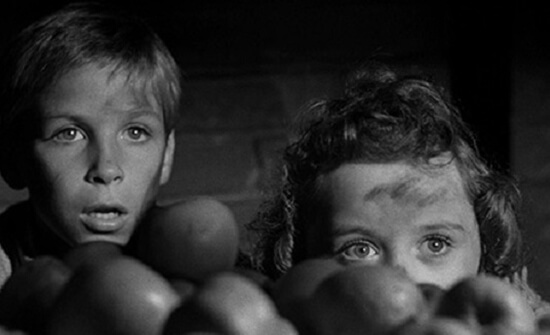 Powell arrives in town, calling himself “Preacher” and making no modest claims to his godliness. Having shared a prison cell with Ben Harper, the scheming Preacher suspects that John and Pearl know where their late father stashed his loot before authorities captured him. Putting his charm to work, Preacher wins over the locals by telling his tale of the battle between Love and Hate, his right-hand and left-hand play representing good and evil. And while the small-town onlookers take to his animated piousness, John alone remains guarded and suspicious. Nevertheless, Preacher slithers his way into marriage with Willa, using sanctity as a lubricant. And he wastes no time intimidating the children as he sniffs about for the hidden cash, which Pearl keeps hidden inside her doll. John and Pearl refuse to give in to Preacher’s questioning and threats, having promised their father they would not tell. However, when Willa hears her new husband threatening Pearl to divulge where her father hid the stolen money, Preacher kills his new wife, leaving no one to stop his mad pursuit of the children.
Powell arrives in town, calling himself “Preacher” and making no modest claims to his godliness. Having shared a prison cell with Ben Harper, the scheming Preacher suspects that John and Pearl know where their late father stashed his loot before authorities captured him. Putting his charm to work, Preacher wins over the locals by telling his tale of the battle between Love and Hate, his right-hand and left-hand play representing good and evil. And while the small-town onlookers take to his animated piousness, John alone remains guarded and suspicious. Nevertheless, Preacher slithers his way into marriage with Willa, using sanctity as a lubricant. And he wastes no time intimidating the children as he sniffs about for the hidden cash, which Pearl keeps hidden inside her doll. John and Pearl refuse to give in to Preacher’s questioning and threats, having promised their father they would not tell. However, when Willa hears her new husband threatening Pearl to divulge where her father hid the stolen money, Preacher kills his new wife, leaving no one to stop his mad pursuit of the children.
Narrowly evading the Preacher’s clutches, John and Pearl escape to the river in their father’s old skiff, meandering with the current on a long journey to safety. Like something out of a storybook or a child’s dream, Mother Nature—a selection of rabbits, frogs, owls, turtles, and spiders—watches over them with an inquisitive calmness. Preacher, meanwhile, tracks them downriver. The small creatures no doubt identify with what it means to be hunted. Through starry nights and serene days on the river, John questions who, if anyone, he can trust. When he and Pearl arrive at the farmhouse of Rachel Cooper (Gish), a kindhearted older woman who has taken in many orphans from the river, he knows he has found a safe haven. The strong-headed Rachel has built her home from her sensible views on the Bible, using it as a guide but not a roadmap, allowing John and Pearl, and all of her orphans, to become independent. They follow their sense of morality—as opposed to values inscribed by a corruptible institution such as organized religion, police, or, to an extent, even parenthood. And it is Rachel’s saintly virtue that ultimately confronts Preacher (with a shotgun, no less) and leads to his demise. In the end, Rachel admits, “It’s a hard world for little things.” But she knows that despite the hardships of the Harpers, children remain resilient creatures. John and Pearl will abide.
The dire, horrific circumstances of the film’s first half, embodied by Preacher’s sadistic villainy, open up to a safer realm where Rachel becomes an impenetrable obstacle, against which Preacher seems almost buffoonish—certainly less threatening. His antagonizing, murderous characterization in the film’s first half and the hopeful message made through children in the second result in an uncanny combination of tonal shifts from the film’s beginning to end. Tragic supporting characters fill the backdrop, bringing further substance to the film’s interchanges between Preacher and the children. Willa remains sympathetic for her desperation—even after she learns that Preacher wants her late husband’s loot, she still believes his godliness will be her salvation. And Uncle Birdie Steptoe (James Gleason), a local drunk befriended by John, promises the boy help should he ever need it. But when Preacher kills Willa and then comes for the children, Uncle Birdie hides in a bottle when the children need him most. Such complex characterizations, taken directly from Grubb’s novel, are infused with rich Southern Gothic traits of deeply flawed and tortured human beings.
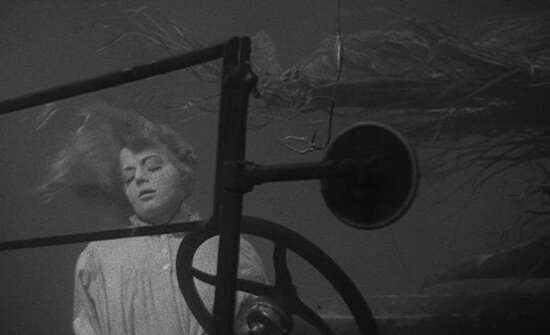 Before filming, Laughton and Grubb developed a unique creative kinship—a willingness to collaborate throughout the writing and pre-production process, rare between a director and author. The two maintained a steady back-and-forth of letters discussing how the novel would be translated to film. Learning that Grubb had studied art, Laughton asked the author to sketch certain scenes as he envisioned them. In their correspondence, Laughton’s typical request of Grubb for “sketches please” came for everything from the layout of a shot to expressions on a character’s face. The film’s events and imagery draw directly from the novel, as does the dialogue—the majority of which, aside from the film’s beginning and ending, is taken verbatim from Grubb’s text. Laughton committed himself to putting Grubb’s dialogue on film, leaving just a few of the film’s lines without a connection to a corresponding line in the novel. Some of the film’s most memorable lines originated in the book. Among the most unshakable lines is Uncle Birdie’s spot-on description of Willa’s corpse underwater: “Down there in the deep place, with her hair waving soft and lazy like meadow grass under floodwater, and that slit in her throat, like she had an extra mouth.”
Before filming, Laughton and Grubb developed a unique creative kinship—a willingness to collaborate throughout the writing and pre-production process, rare between a director and author. The two maintained a steady back-and-forth of letters discussing how the novel would be translated to film. Learning that Grubb had studied art, Laughton asked the author to sketch certain scenes as he envisioned them. In their correspondence, Laughton’s typical request of Grubb for “sketches please” came for everything from the layout of a shot to expressions on a character’s face. The film’s events and imagery draw directly from the novel, as does the dialogue—the majority of which, aside from the film’s beginning and ending, is taken verbatim from Grubb’s text. Laughton committed himself to putting Grubb’s dialogue on film, leaving just a few of the film’s lines without a connection to a corresponding line in the novel. Some of the film’s most memorable lines originated in the book. Among the most unshakable lines is Uncle Birdie’s spot-on description of Willa’s corpse underwater: “Down there in the deep place, with her hair waving soft and lazy like meadow grass under floodwater, and that slit in her throat, like she had an extra mouth.”
However, while Grubb’s memorable dialogue finds its way into the film, Laughton’s most impressive feat in honoring his source was the imagery used to evoke the author’s prose on film. Consider the same example of Willa’s submerged and waterlogged body. Makeup artist Maurice Seiderman created a wax dummy for the ghostly scene, sparing no detail, not even the slit throat. Seiderman’s dummy, submerged in a tank along with the car, looks shockingly like Shelley Winters. A hose spraying into the tank created the illusion of a current, while massive lamps give the image a wraithlike feeling of poetic beauty yet grim unease. It remains among the most striking visuals in this or any film. Or consider the appearance of Preacher suddenly in Ruby’s home when he steps on her cat: “He rocketed suddenly upward before her very eyes, his twisted mask caught for one split second in the silver moonlight like a vision in a photograph negative,” wrote Grubb. Mitchum likewise bursts onscreen to achieve the film’s most startling jump, a moment perfectly in synch with the writer’s description.
Though Laughton’s ability as a film director was untested, he could not help but identify with many of the novel’s themes and emphasize them onscreen. While making cuts to Grubb’s text, he maintains that the book was, in essence, a condemnation of the church. Laughton revolted from his firm Roman Catholic background in his early years and, throughout his life, opposed the idea of organized religion. Yet, for all its talk of religion, Grubb’s novel contained a message that, for Laughton, argued faith was better practiced by a kind old farm woman than a man who called himself “Preacher” and justified his criminality in the name of the Bible. Laughton stresses that the blind trust for religion is a folly of the characters duped by Preacher, leading several religious groups and censors to condemn the film for its particular portrait of religious sanctities, such as marriage. And yet, the film ends on a pleasant Christmas morning, where religion is no longer distorted into something dangerous and perverse. At the center of the narrative is the spiritual conflict between good and evil, where Laughton emphasizes the warning that either party can use religion to serve their cause. Still, he concludes the picture with the novel’s hopeful ending.
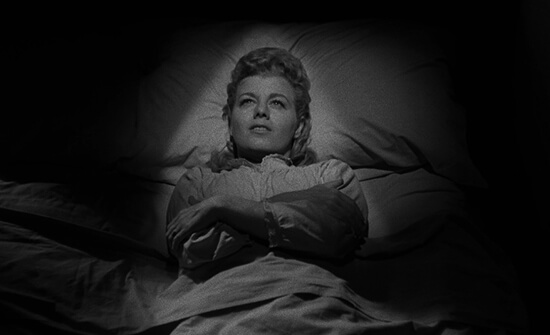 In relation to religion, sexuality plays a major role in Grubb’s text and Laughton’s adaptation, using imagery both graphic and shocking, particularly for 1955 audiences. The sexual undercurrent advances in tandem with themes of Christian guilt—pronounced by Preacher’s murderous response to his sexual repression and Willa’s desire to cleanse her soul by marrying a holy man. Preacher’s switchblade, for example, delivers a powerful phallic symbol of the character’s violent inner conflict amid his repressed drives and religious allegiance. In a scene exclusive to the film, Preacher makes his first appearance at a burlesque show; he watches both aroused and revolted, and suddenly he flips the switch on his knife within his pocket, forcing the erect blade through his coat pocket. After he and Willa marry, Preacher turns down the lonely former widow’s expectations for their wedding night when he informs his new wife that the night will not, nor will their marriage ever, involve consummation. Out of shame, she accepts this for leading a life of sin with her late convicted-criminal husband. Though Preacher resists Willa, as he kills her, he cannot help but lay atop her corpse in a moment of repressed necrophilia.
In relation to religion, sexuality plays a major role in Grubb’s text and Laughton’s adaptation, using imagery both graphic and shocking, particularly for 1955 audiences. The sexual undercurrent advances in tandem with themes of Christian guilt—pronounced by Preacher’s murderous response to his sexual repression and Willa’s desire to cleanse her soul by marrying a holy man. Preacher’s switchblade, for example, delivers a powerful phallic symbol of the character’s violent inner conflict amid his repressed drives and religious allegiance. In a scene exclusive to the film, Preacher makes his first appearance at a burlesque show; he watches both aroused and revolted, and suddenly he flips the switch on his knife within his pocket, forcing the erect blade through his coat pocket. After he and Willa marry, Preacher turns down the lonely former widow’s expectations for their wedding night when he informs his new wife that the night will not, nor will their marriage ever, involve consummation. Out of shame, she accepts this for leading a life of sin with her late convicted-criminal husband. Though Preacher resists Willa, as he kills her, he cannot help but lay atop her corpse in a moment of repressed necrophilia.
Placing Robert Mitchum in the role of Preacher was Laughton’s stroke of casting genius. Though the director had initially sought Gary Cooper, who turned the offer down for fear that it would tarnish his public image, his second choice was Mitchum. The experienced and pointedly enigmatic actor’s reputation and onscreen persona were already that of a Hollywood hellraiser, albeit a charming one. After Mitchum’s arrest for marijuana possession in 1948, the tabloids cemented the actor’s status as a bad boy. But regardless of his criminal ways, he remained a popular star—if for the thrilling sense of authentic danger he brought to the screen. Playing the charming yet devilish Preacher, Mitchum’s mannerisms and public reputation became qualities employed by Laughton to enhance the role’s sexually repressed yet religiously motivated duality. Both the actor and his part contained charismatic qualities, backed by an underlying sense of calm and collected danger. Yet, Mitchum lends the performance frighteningly unhinged displays of rage and howls of almost comic lapses of composure.
Mitchum is so charming yet disturbing in the scene when he demonstrates the battle between Love and Hate with his two opposing hands, or when he calmly threatens John by tightening his collar in front of everyone at a picnic. His physical mannerisms reflect the abnormal person underneath his good looks, from how he contorts his body in a twisted S-curve when reaching toward the heavens just before killing Willa to the way he bows his head in false sorrow over her death. Such menacing, intentional behavior from Preacher deteriorates when he loses control or faces an emergency. For example, when he chases the children upstairs from the cellar, they slam his fingers in the door. He yelps and then sucks on them in a moment of absurd frailty. When the children escape on their father’s skiff downriver, his total loss of composure grows into a madman’s scream. When he takes a shotgun blast from Rachel, he runs off, hollering like a wounded hound dog. His human vulnerability makes the character more than just evil but a personification of the human beast at its worst, complete with human flaws and weaknesses.
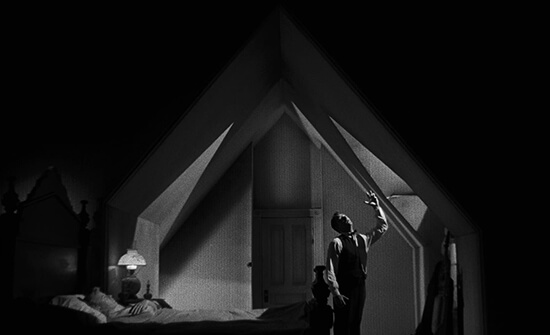 Besides Mitchum, Laughton cast supporting actors who would disappear into their roles. Lillian Gish had been a source of joy for Laughton during his tour in World War I, especially after seeing her in Broken Blossoms (1919) several times. In 1962, Laughton awoke from a coma on his deathbed to announce, “I fell in love with Lillian Gish.” She seemed to embody resounding decency for the director, and he could envision no one else playing Rachel. Gish had since retired from acting after her experience with David O. Selznick making Duel in the Sun (1946), but Laughton convinced her to join the cast by selling the purity of the role. Elsewhere, Shelley Winters, one of Laughton’s acting students, was honored that her teacher offered her the part of Willa. She would play a similar broken widow role in 1962 for Stanley Kubrick’s Lolita. James Gleason, an Oscar nominee for Here Comes Mr. Jordan (1941) and lifelong performer in the theater, gave life to Uncle Birdie Steptoe. After some acclaimed experience on Broadway, nine-year-old actor Billy Chapin was cast as the child hero, John. And the untested Sally Jane Bruce played Pearl in her sole foray into acting.
Besides Mitchum, Laughton cast supporting actors who would disappear into their roles. Lillian Gish had been a source of joy for Laughton during his tour in World War I, especially after seeing her in Broken Blossoms (1919) several times. In 1962, Laughton awoke from a coma on his deathbed to announce, “I fell in love with Lillian Gish.” She seemed to embody resounding decency for the director, and he could envision no one else playing Rachel. Gish had since retired from acting after her experience with David O. Selznick making Duel in the Sun (1946), but Laughton convinced her to join the cast by selling the purity of the role. Elsewhere, Shelley Winters, one of Laughton’s acting students, was honored that her teacher offered her the part of Willa. She would play a similar broken widow role in 1962 for Stanley Kubrick’s Lolita. James Gleason, an Oscar nominee for Here Comes Mr. Jordan (1941) and lifelong performer in the theater, gave life to Uncle Birdie Steptoe. After some acclaimed experience on Broadway, nine-year-old actor Billy Chapin was cast as the child hero, John. And the untested Sally Jane Bruce played Pearl in her sole foray into acting.
Laughton also hand-picked his crew to support a production grounded by artistic collaboration. Many historians attribute Laughton’s allowances of creative freedom to his lack of technical expertise as a film director; he knew what he wanted to see on the screen, just not how to manufacture it. Cinematographer Stanley Cortez shot The Magnificent Ambersons (1942) for Orson Welles; although, the classicized style of that film was a complete contrast from the theatrical staging and chiaroscuro light he uses in The Night of the Hunter, both testaments to Cortez’s versatility within his craft. Composer Walter Schumann was given unique freedom as a composer when Laughton demanded that his score not re-emphasize what the actors should already be conveying; rather, Laughton instructed him to build on the power of the narrative by affixing an additional layer. Since Laughton the Actor came with a reputation for being difficult and demanding, if not ruthlessly committed to his artistic ideals, the collaborative atmosphere he created on set was unprecedented in his career. He was noted for shouting out, “What do I do now” or “I’m confused,” yet he was also the undisputed leader on set, a democratic captain ever open to ideas. He may not have been able to articulate in filmic technical terminology what he had wanted before filming had begun, but when it was over, The Night of the Hunter was just as Laughton had envisioned.
Laughton’s direction resulted in a limited number of shots per scene, bringing to mind the precision of a silent filmmaker. The influence of German Expressionists and the spatial understanding of D.W. Griffith have undeniable influence over Laughton’s direction—as mentioned, he relished the days of growing up with Gish’s many appearances in Griffith’s films (nearly forty between 1912 and 1921). Laughton encouraged his crew to see key Griffith silents prior to filming—titles like The Birth of a Nation (1915), Intolerance (1916), and Broken Blossoms (1919). His use of Griffith-esque tracking shots and crisp photography replicated what the director hoped was a cinematic classicism not attained since the Silent Era. Laughton told Gish, “When I first went to the movies, they sat in their seats straight and leaned forward. Now they slump down, with their heads back or eat candy and popcorn. I want them to sit up straight again.” Even so, his uncommon directing approach served actors and enriched performances—those were his origins, after all. He kept the camera rolling between takes and allowed his actors to try the scene again as he talked them through it.
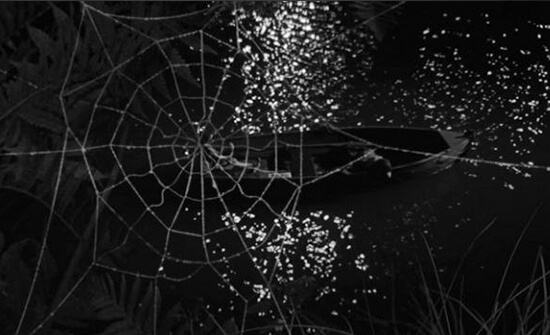 Laughton avoided realism and, shooting almost entirely in the studio, enhanced the qualities of the film’s artifice to stress the story’s allegory through theatricality. Curiously, though, Laughton’s choices and those of his crew play out with incredible resourcefulness. His expressive environments consist of highly stylized set pieces that evoke a precise feeling, inspired by Grubb’s expressionist conceptual sketches made for Laughton in pre-production. The film’s environments looked handmade and toiled upon by a crew that was encouraged by Laughton to improvise using their artistic abilities. Production designer Hilyard Brown, who had previously assisted Perry Ferguson on Citizen Kane (1941), worked with Laughton to design each set from a child’s point of view to achieve the desired fairy tale quality. The film’s world is meant to appear unrealistic and distorted, even artificial. During the river scene, the painted backdrop does not intend tromp l’oeil detail; instead, the farmhouse and barn look like pictures from a giant pop-up storybook. Under Laughton’s strict oversight, Brown constructed sets that represent a not quite realist world—abstracted to evoke a child’s impression of the film’s already skewed perspective. Cortez carried these details further through vibrant angles and lighting.
Laughton avoided realism and, shooting almost entirely in the studio, enhanced the qualities of the film’s artifice to stress the story’s allegory through theatricality. Curiously, though, Laughton’s choices and those of his crew play out with incredible resourcefulness. His expressive environments consist of highly stylized set pieces that evoke a precise feeling, inspired by Grubb’s expressionist conceptual sketches made for Laughton in pre-production. The film’s environments looked handmade and toiled upon by a crew that was encouraged by Laughton to improvise using their artistic abilities. Production designer Hilyard Brown, who had previously assisted Perry Ferguson on Citizen Kane (1941), worked with Laughton to design each set from a child’s point of view to achieve the desired fairy tale quality. The film’s world is meant to appear unrealistic and distorted, even artificial. During the river scene, the painted backdrop does not intend tromp l’oeil detail; instead, the farmhouse and barn look like pictures from a giant pop-up storybook. Under Laughton’s strict oversight, Brown constructed sets that represent a not quite realist world—abstracted to evoke a child’s impression of the film’s already skewed perspective. Cortez carried these details further through vibrant angles and lighting.
Each dynamic set-piece keeps the audience on edge. Scene after scene, the sets present a playful exchange of styles, forcing viewers to ask how the filmmakers created this unnatural storybook. Cortes shot many of the interiors in the style of German Expressionists, casting grave shadows with sharp angles and high contrasts. He shot exterior scenes with the dreaminess of a rural haven inspired by Griffith. The cellar where Preacher tries to capture the children and the A-framed bedroom where he kills Willa were detached set pieces, made small to suggest a claustrophobic and deadly environment. What is more, Cortes frames the rooms in pitch darkness for dramatic effect, sometimes relying on no more than a single candle as a light source. The same sets could have been placed on a stage had The Night of the Hunter been a Laughton theater production. In the former example, the surrounding black of the cellar isolates the children with the approaching Preacher; in the latter, the A-framed bedroom suggests a cathedral space that has become holy with the Preacher’s presence—certainly no place for a husband and wife to engage in “dirty” acts.
In keeping with the stylized, exaggerated quality of the picture, Mitchum presents Preacher Harry Powell as a monster both in his actions and the dialogue about him, far beyond just a twisted killer using the pretense of godliness to gain the trust of his victims. The title refers to him as a “hunter” of the “night,” not unlike a vampire. The rhetoric used by Rachel is most revealing: When Preacher retreats after being shot, she describes him like an animal to the police: “Get your state troopers out to my place. I’ve got somethin’ trapped in my barn.” The imagery evoked here suggests Preacher is some nocturnal wild animal hungry for flesh. When he chases the children up the stairs from the cellar, his arms are stretched out straight, rigid and reaching, like the monster from James Whale’s Frankenstein of 1931. Likewise, in the finale, a lynch mob out for the Preacher’s blood recalls the one from Whale’s film, carrying torches in the night to expel the evil from their sleepy community.
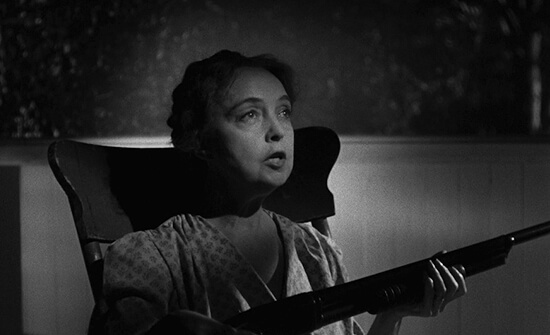 If Preacher represents a monster, Rachel is an angelic protector-storyteller of sorts, shielding the children, and the audience, from the evil that lurks in the world. Her initial appearance in the film’s prologue makes the character seem like a device to set the narrative’s themes into place, until, more than an hour into the film, John and Pearl come to Rachel’s home, where she saves them. The camera looks up again at this moment to a starry sky, and the audience knows the children are safe from their nightmare—the storyteller, Rachel, will protect them. In a way, The Night of the Hunter is a story told by Rachel to children, which would account for the film’s changing perspectives and unmistakable fairy-tale quality. When she reads aloud, she does so for the children, but she also seems to speak directly to the audience. In the final scene, Rachel addresses the audience directly, almost looking into the camera with her final words of assurance on the resilience of children: “They abide, and they endure.”
If Preacher represents a monster, Rachel is an angelic protector-storyteller of sorts, shielding the children, and the audience, from the evil that lurks in the world. Her initial appearance in the film’s prologue makes the character seem like a device to set the narrative’s themes into place, until, more than an hour into the film, John and Pearl come to Rachel’s home, where she saves them. The camera looks up again at this moment to a starry sky, and the audience knows the children are safe from their nightmare—the storyteller, Rachel, will protect them. In a way, The Night of the Hunter is a story told by Rachel to children, which would account for the film’s changing perspectives and unmistakable fairy-tale quality. When she reads aloud, she does so for the children, but she also seems to speak directly to the audience. In the final scene, Rachel addresses the audience directly, almost looking into the camera with her final words of assurance on the resilience of children: “They abide, and they endure.”
The film’s storybook effect also comes from Walter Schumann’s music. Schumann had previously worked with Laughton on a stage production of John Brown’s Body, on which he sung an eerie a cappella score with his choral group, called the Voices of Walter Schumann. When Laughton hired him again for The Night of the Hunter, their collaboration became a close working partnership, more so than most director-composer relationships. Schumann remained on set during production, writing music before a scene and playing it for the cast and crew to set the mood. Schumann even made vital suggestions on the set, such as how Mitchum should call for John and Pearl, saying “Chil-dren” with just the right octave inflection mid-word to make it menacing. Laughton called Schumann his “right hand” and offered the composer unparalleled control in the film’s construction, as this is a picture shaped by music. To be sure, Schumann captures the film’s paradoxical quality through musical contrasts. When Preacher is onscreen boasting his false Christian ideals, Schumann plays a “pagan” motif; when an ominous night sky suggests something sinister, he introduces a lullaby to defuse the image.
Such contrasts gave way to the film’s elusive quality, and Gregory knew that the marketing approach had to be equally unique to sell the film to American audiences. He originally wanted to take the film on a roadshow, selling it in specialized screenings, versus unleashing an artistic curiosity before the entire nation and hoping it comes out all right. Gregory understood that such an atypical picture required an equally nonconforming approach to succeed. But the distributors at United Artists, who did not consider the project worthy of specialized attention, pushed for the standard release strategy and ultimately won. Within a few short weeks after the quiet premiere, the film was placed on the bottom of a double-bill. The initial reviews received The Night of the Hunter with understandable perplexity. Though the critics were impressed with Laughton’s direction, Mitchum’s performance, and the production style, the material left many critics unconvinced, despite the novel being a national best-seller two years prior. Laughton’s close collaboration with Grubb meant the film captured the book’s stranger qualities in enhanced visual reality, but seeing those qualities brought to life onscreen is something no audience can fully grasp in a single screening. The New York Times critic called the film “weird and intriguing,” though evidently puzzling as he remains indifferent. The dubious Los Angeles Herald review called it simply “curious.” These typical assessments, wrought by uncertainty yet distant admiration, would grow over time into enthusiastic praise.
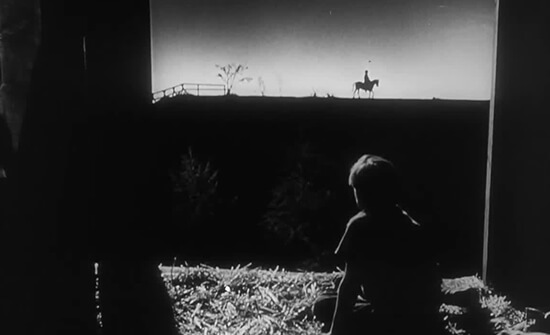 After production wrapped on The Night of the Hunter, Laughton immediately began preparations for his next directorial effort, an adaptation of Norman Mailer’s The Naked and the Dead. But the commercial failure and indefinite critical reception of his first film robbed Laughton of his artistic motivation as a director. Moreover, friends and crew members said that the film’s failure broke Laughton’s heart. As a result, Laughton gave up on a second directorial effort, and following that decision, he ended his partnership with Gregory for reasons that have never been fully explained. Nevertheless, Gregory followed through as producer on the Warner Bros. production of The Naked and the Dead, released in 1958, which Raoul Walsh directed into a listless World War II epic whose devotion to the source material was nil. Returning to stage productions, Gregory eventually retired from show business. Defeated, Laughton returned to the stage, made appearances in a few films such as Billy Wilder’s Witness for the Prosecution (1957) and Stanley Kubrick’s Spartacus (1962), and then, in 1962, died of spinal cancer.
After production wrapped on The Night of the Hunter, Laughton immediately began preparations for his next directorial effort, an adaptation of Norman Mailer’s The Naked and the Dead. But the commercial failure and indefinite critical reception of his first film robbed Laughton of his artistic motivation as a director. Moreover, friends and crew members said that the film’s failure broke Laughton’s heart. As a result, Laughton gave up on a second directorial effort, and following that decision, he ended his partnership with Gregory for reasons that have never been fully explained. Nevertheless, Gregory followed through as producer on the Warner Bros. production of The Naked and the Dead, released in 1958, which Raoul Walsh directed into a listless World War II epic whose devotion to the source material was nil. Returning to stage productions, Gregory eventually retired from show business. Defeated, Laughton returned to the stage, made appearances in a few films such as Billy Wilder’s Witness for the Prosecution (1957) and Stanley Kubrick’s Spartacus (1962), and then, in 1962, died of spinal cancer.
It took years for the initial bafflement over the film to pass. Gradually, a film once shamed as being too arty and employing far too many styles was seen through different eyes after New Wave cinema hit France and the rebel filmmakers of the 1970s struck Hollywood. Truffaut, Martin Scorsese, Jean-Luc Godard, Roman Polanski, Robert Altman, and many other filmmakers began to work in a style that Laughton predicted—a class of directing in which influences are transformed and repurposed by auteurs into something altogether new. The Night of the Hunter became a lost masterpiece, now rediscovered with renewed perspectives from an era defined by its innovation on earlier styles. The Library of Congress has since selected it for the National Film Registry’s preservation of “culturally, historically, or aesthetically important” films. It has also appeared on countless “best films” lists, including its high ranking on the British film magazine Sight and Sound’s critics’ and directors’ polls.
That The Night of the Hunter was Charles Laughton’s first effort as a director is remarkable. That it was his only film behind the camera is one of cinema’s most unfortunate tragedies. Laughton made a picture that does not reveal every facet to the viewer upon first viewing; instead, the first watch only implants a desire to explore it further. The film percolates with memory and time, cultivating a place in the unconscious mind, one watch after another, until it becomes fixed. The effect is comparable to Welles’ Citizen Kane, in that Laughton’s directorial debut constructed a film so masterful, so complex, few viewers could fully appreciate its full effect in its day. The film proves so uncommon that it demands further assessment just to understand the many ways it deviates from the norm. Each aspect of the film’s production—from the idyllic cinematography to the incredible performances to the contrary uses of cinematic stylization and narrative—presents an interplay of opposing ideas through a sophisticated, haunting, and strangely buoyant whole. It endures as an enchanting American folk tale ripe with intricate melodrama and almost mythic symbolism, which no moviegoer can easily shake.
Bibliography:
Bergreen, Laurence. James Agee: A Life. Dutton, 1984.
Callow, Simon. Charles Laughton: A Difficult Actor. Methuen, 1987.
Callow, Simon. The Night of the Hunter. BFI Film Classics.BFI, 2000.
Couchman, Jeffrey. The Night of the Hunter: A Biography of a Film. Northwestern University Press, 2009.
Grubb, Davis. The Night of the Hunter. Harper, 1953.
Higham, Charles. Charles Laughton: An Intimate Biography. Doubleday, 1976.
Jones, Preston Neal. Heaven and Hell to Play With: The Filming of ‘The Night of the Hunter.’ Limelight, 2004.
Kramer, Victor. James Agee. Twayne, 1975.

Support Deep Focus Review
Help keep independent film criticism alive by supporting Deep Focus Review on Patreon. Since 2007, I’ve aimed to deliver critical analysis and in-depth reviews, free from outside influence. Your contribution not only gives you access to exclusive reviews and essays before anyone else, but it also helps me maintain the site, access research materials, and ensure Deep Focus Review keeps going strong. If you enjoy my work, please consider joining me on Patreon or showing your support in other ways. Thank you for your readership!




